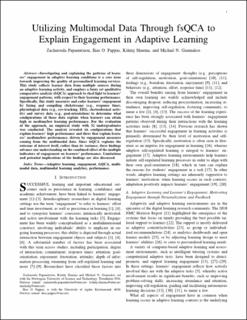Utilizing Multimodal Data Through fsQCA to Explain Engagement in Adaptive Learning
Peer reviewed, Journal article
Accepted version
Permanent lenke
https://hdl.handle.net/11250/2724721Utgivelsesdato
2020Metadata
Vis full innførselSamlinger
Sammendrag
Investigating and explaining the patterns of learners’ engagement in adaptive learning conditions is a core issue towards improving the quality of personalized learning services. This article collects learner data from multiple sources during an adaptive learning activity, and employs a fuzzy set qualitative comparative analysis (fsQCA) approach to shed light to learners’ engagement patterns, with respect to their learning performance. Specifically, this article measures and codes learners’ engagement by fusing and compiling clickstreams (e.g., response time), physiological data (e.g., eye-tracking, electroencephalography, electrodermal activity), and survey data (e.g., goal-orientation) to determine what configurations of those data explain when learners can attain high or medium/low learning performance. For the evaluation of the approach, an empirical study with 32 undergraduates was conducted. The analysis revealed six configurations that explain learners’ high performance and three that explain learners’ medium/low performance, driven by engagement measures coming from the multimodal data. Since fsQCA explains the outcome of interest itself, rather than its variance, these findings advance our understanding on the combined effect of the multiple indicators of engagement on learners’ performance. Limitations and potential implications of the findings are also discussed.
